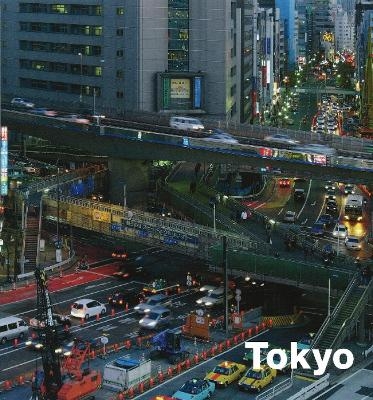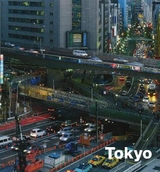Tokyo
Seiten
2009
Edition Axel Menges (Verlag)
978-3-936681-27-7 (ISBN)
Edition Axel Menges (Verlag)
978-3-936681-27-7 (ISBN)
- Titel ist leider vergriffen;
keine Neuauflage - Artikel merken
Cities are often seen as symbols of order: the existence of city walls, fortified gates, palaces, temples, roads, pavements, highways, public institutions, city centres and residential areas is nterpreted as indicating the existence of a central authority that plans and controls the city. On the other hand, the very same cities are also seen as symbols of spontaneous growth. The little winding streets and alleys, the mixture of physical structures, styles and human activities have often given the impression that cities, like forests, and other natural entities are organic structures - strange 'natural artifacts'. Tokyo is a good example for this dual nature of cities. When you first encounter it, you get the impression of chaos: old buildings with one or two storeys next to 30-, 40- or 50-storey skyscrapers; pedestrians, cars, trains moving in all directions, each with its own trajectory. But then you realize that this seemingly chaotic structure provides a context for perfectly ordered human activities: trains leave and arrive as timetabled, their doors open at the exact points that are marked with yellow lines on the platforms; early in the morning fishermen bring their catch to Tokyo's big fish market, auctions are held, and by six o'clock this huge amount of sea food has already been distributed among thousands of restaurants all over the city. And if you look deeper you learn that the chaotic face of Tokyo is the precondition for its ordered and organized life.
Cities are often seen as symbols of order: the existence of city
walls, fortified gates, palaces, temples, roads, pavements, highways,
public institutions, city centres and residential areas is interpreted
as indicating the existence of a central authority that plans
and controls the city. On the other hand, the very same cities are
also seen as symbols of spontaneous growth. The little winding
streets and alleys, the mixture of physical structures, styles and
human activities have often given the impression that cities, like
forests, and other natural entities are organic structures – strange
'natural artifacts'.
Tokyo is a good example for this dual nature of cities. When you
first encounter it, you get the impression of chaos: old buildings
with one or two storeys next to 30-, 40- or 50-storey skyscrapers;
pedestrians, cars, trains moving in all directions, each with its own
trajectory. But then you realize that this seemingly chaotic structure
provides a context for perfectly ordered human activities: trains
leave and arrive as timetabled, their doors open at the exact points
that are marked with yellow lines on the platforms; early in the
morning fishermen bring their catch to Tokyo’s big fish market, auctions
are held, and by six o’clock this huge amount of sea food has
already been distributed among thousands of restaurants all over
the city. And if you look deeper you learn that the chaotic face of
Tokyo is the precondition for its ordered and organized life.
Complexity theory or self-organization theory are umbrella terms
for a set of theories that study the interplay between chaos and
order. Originating in the sciences, these theories have been applied
to the study of cities in the last three decades. They show that as
in natural systems, in the artificial systems that we call cities, chaos
and order do not stand in opposition to each other. Rather, they
coexist in an ongoing interplay of circular causality: chaos is the precondition
for new urban orders to emerge and then to reproduce
themselves, whereas order and organization set the boundaries
within which chaotic structures and behaviors can take place.
Juval Portugali is professor of human geography in the Department
of Geography and the Human Environment at Tel Aviv University.
His research is devoted to the city as a self-organizing system.
In addition to his teaching in Israel, he has taught at many universities
outside his home country as a guest professor, including Tokyo
University. Wolf-Dieter Gericke studied architecture at Stuttgart University.
He works as a free-lance photographer and designer in
Waiblingen near Stuttgart. He has been visiting Tokyo almost every
year for some time now.
Cities are often seen as symbols of order: the existence of city
walls, fortified gates, palaces, temples, roads, pavements, highways,
public institutions, city centres and residential areas is interpreted
as indicating the existence of a central authority that plans
and controls the city. On the other hand, the very same cities are
also seen as symbols of spontaneous growth. The little winding
streets and alleys, the mixture of physical structures, styles and
human activities have often given the impression that cities, like
forests, and other natural entities are organic structures – strange
'natural artifacts'.
Tokyo is a good example for this dual nature of cities. When you
first encounter it, you get the impression of chaos: old buildings
with one or two storeys next to 30-, 40- or 50-storey skyscrapers;
pedestrians, cars, trains moving in all directions, each with its own
trajectory. But then you realize that this seemingly chaotic structure
provides a context for perfectly ordered human activities: trains
leave and arrive as timetabled, their doors open at the exact points
that are marked with yellow lines on the platforms; early in the
morning fishermen bring their catch to Tokyo’s big fish market, auctions
are held, and by six o’clock this huge amount of sea food has
already been distributed among thousands of restaurants all over
the city. And if you look deeper you learn that the chaotic face of
Tokyo is the precondition for its ordered and organized life.
Complexity theory or self-organization theory are umbrella terms
for a set of theories that study the interplay between chaos and
order. Originating in the sciences, these theories have been applied
to the study of cities in the last three decades. They show that as
in natural systems, in the artificial systems that we call cities, chaos
and order do not stand in opposition to each other. Rather, they
coexist in an ongoing interplay of circular causality: chaos is the precondition
for new urban orders to emerge and then to reproduce
themselves, whereas order and organization set the boundaries
within which chaotic structures and behaviors can take place.
Juval Portugali is professor of human geography in the Department
of Geography and the Human Environment at Tel Aviv University.
His research is devoted to the city as a self-organizing system.
In addition to his teaching in Israel, he has taught at many universities
outside his home country as a guest professor, including Tokyo
University. Wolf-Dieter Gericke studied architecture at Stuttgart University.
He works as a free-lance photographer and designer in
Waiblingen near Stuttgart. He has been visiting Tokyo almost every
year for some time now.
| Vorwort | Juval Portugali |
|---|---|
| Sprache | englisch |
| Maße | 280 x 300 mm |
| Gewicht | 810 g |
| Einbandart | gebunden |
| Themenwelt | Reisen ► Bildbände ► Asien |
| Technik ► Architektur | |
| Schlagworte | Tokio; Bildband • Tokio, Kunst; Architektur |
| ISBN-10 | 3-936681-27-9 / 3936681279 |
| ISBN-13 | 978-3-936681-27-7 / 9783936681277 |
| Zustand | Neuware |
| Haben Sie eine Frage zum Produkt? |
Mehr entdecken
aus dem Bereich
aus dem Bereich
Forschungsexpeditionen zu den spektakulärsten Orten der Erde
Buch | Hardcover (2023)
Prestel (Verlag)
49,00 €




